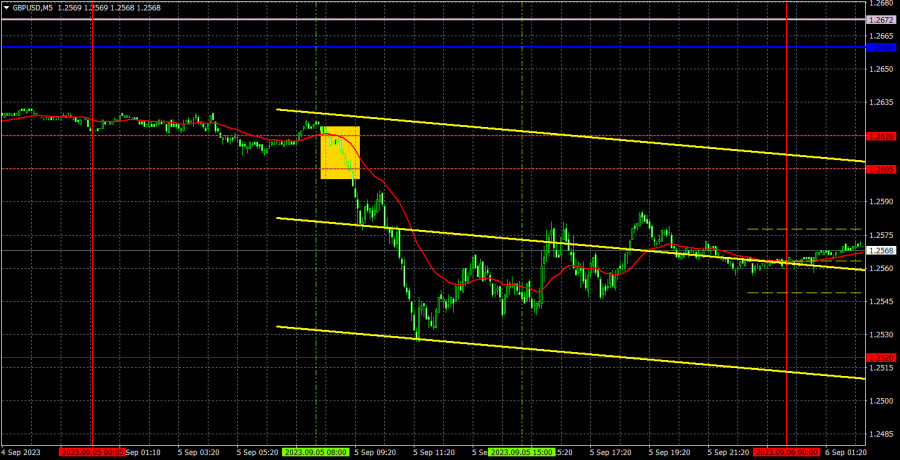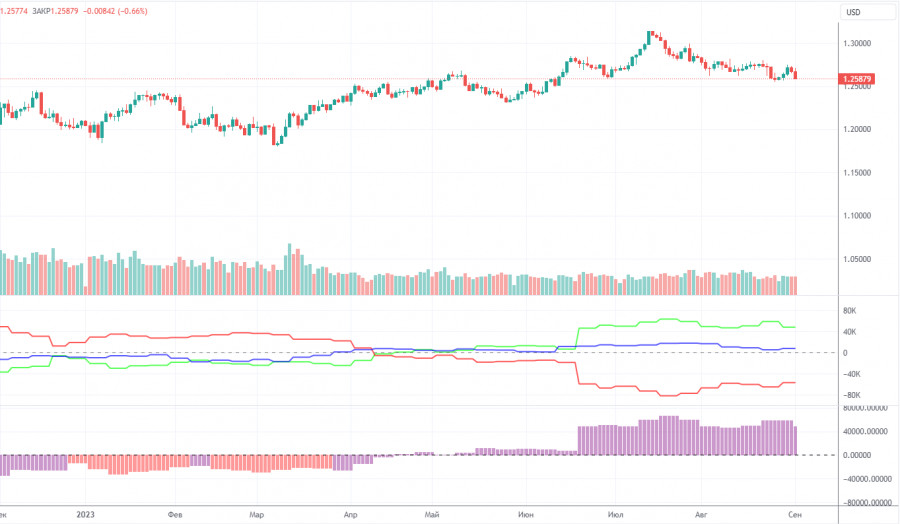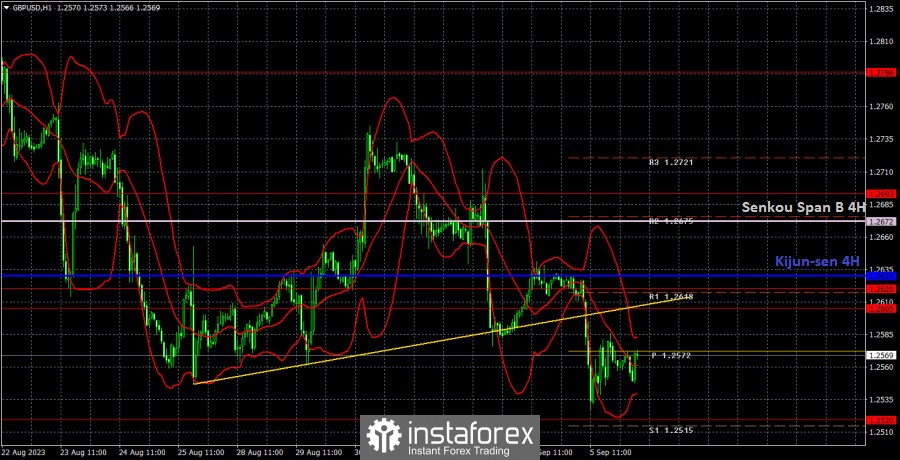Analysis of GBP/USD 5M
GBP/USD also traded lower on Tuesday, but not for the entire day. The pair returned to the red zone for a few hours during the European trading session. There were no macroeconomic or fundamental events in the UK or the US. Therefore, we came to the conclusion that the British pound followed the euro, which had a reason to fall. The pound weakened to a lesser extent, highlighting its resistance. Perhaps the market believes that the Bank of England will remain hawkish, but with the UK interest rate already at 5.25%, it becomes increasingly difficult to believe in new rate hikes. Moreover, the market has had enough time to price in all the rate hikes in advance.
There was only one trading signal during the day. At the very beginning of the European session, the pair broke through the 1.2605-1.2620 range, afterwards it almost managed to fall to the target level of 1.2520 but fell short by just a few pips. Otherwise, we would have had a perfect setup and a buy signal, which would have been profitable. However, the trade had to be manually closed closer to the evening, with just 25 pips of profit. It's not much, but it could have been less if there had been at least one significant level in the pair's path in the second half of the day. This is when the market started to move sideways, which always carries the risk of many false signals.
COT report:
According to the latest report, the non-commercial group of traders closed 900 long positions and opened 9,800 short ones. Thus, the net position of non-commercial traders decreased by 10,700 positions in a week. The net position has been steadily growing over the past 11 months as well as the pound sterling. Now, the net position has advanced markedly. This is why the pair will hardly maintain its bullish momentum. I believe that a long and protracted downward movement should begin. COT reports signal a slight growth of the British currency but it will not be able to rise in the long term. There are no drivers for opening new long positions. Sell signals are starting to appear on the 4-hour and 24-hour charts.
The British currency has already grown by a total of 2,800 pips, from its absolute lows reached last year, which is a significant increase. Without a downward correction, the continuation of the uptrend will be illogical. We are not against the uptrend; we just believe a solid correction is needed first. The market perceives the fundamental background one-sidedly, ignoring any data in favor of the dollar. The Non-commercial group of traders has a total of 97,000 long positions and 48,700 short ones. I remain skeptical about the long-term growth of the pound sterling, and the market has recently started to pay more attention to selling.
Analysis of GBP/USD 1H
On the 1H chart, GBP/USD has settled below the ascending trendline, which shows that it may continue its downward movement. The price is also below the Ichimoku indicator lines. The pair could show erratic movements amid the weak fundamental background. The bias remains bearish but the pair is not in a hurry to move downward.
On September 6, traders should pay attention to the following key levels: 1.2349, 1.2429-1.2445, 1.2520, 1.2605-1.2620, 1.2693, 1.2786, 1.2863. The Senkou Span B (1.2672) and Kijun-sen (1.2630) lines can also be sources of signals, e.g. rebounds and breakout of these levels and lines. It is recommended to set the Stop Loss orders at the breakeven level when the price moves in the right direction by 20 pips. The lines of the Ichimoku indicator can move during the day, which should be taken into account when determining trading signals. There are support and resistance levels that can be used to lock in profits.
On Wednesday, there are no important reports or events planned in the UK, while the US will release an important report on the ISM Non-Manufacturing Purchasing Managers' Index. However, the report could only trigger a significant reaction if its figures significantly deviate from forecasts.
Description of the chart:
Support and resistance levels are thick red lines near which the trend may end. They do not provide trading signals;
The Kijun-sen and Senkou Span B lines are the lines of the Ichimoku indicator, plotted to the 1H timeframe from the 4H one. They provide trading signals;
Extreme levels are thin red lines from which the price bounced earlier. They provide trading signals;
Yellow lines are trend lines, trend channels, and any other technical patterns;
Indicator 1 on the COT charts is the net position size for each category of traders;
Indicator 2 on the COT charts is the net position size for the Non-commercial group.














